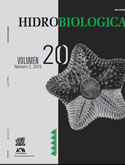Hydrologic ecosystem services: water quality and quantity in the Magdalena River, Mexico City
Palabras clave:
Water balance, ecosystem management, physico-chemical and biological indicators.Resumen
The increasing urbanization in big cities, that jeopardizes the ecosystems, makes it important to protect them as well as to recognize and manage the services they provide. In order to have the required scientific evidence to support conservation projects, an assessment of water quality and quantity seen as hydrological ecosystem services in the Magdalena River watershed, was carried out. Water quality was assessed in two annual cycles based on physicochemical, chemical, bacteriological and algal indicators, showing an abrupt change between the natural and urbanized areas. This has the potential to affect negatively the recreational activities practised in the area. The relevance of the indicators for water quality is that they show different aspects of the problem: physical and chemical parameters indicate variations across sites along the Magdalena River and point the places where domestic discharges occur. Algae reveal the natural conditions of the habitat and the risks to public health can be assessed with bacteriological indicators. To calculate the water quantity, balances were made in order to know the amount of water that runoff in the three dominant plant communities: the fir forest that generates 10,944,800 m3 of water per year, the pine forest generates 6,878,000 m3 and the mixed and oak forest generates 3,217,500 m3 . It is important to preserve the hydrological ecosystem services conserving the forests and rehabilitating the Magdalena River in order to enhance the provision of drinking water to the southern part of Mexico City.Descargas
Descargas
Publicado
Cómo citar
Número
Sección
Licencia
Los autores/as que publiquen en esta revista aceptan las siguientes condiciones:
De acuerdo con la legislación de derechos de autor, HIDROBIOLÓGICA reconoce y respeta el derecho moral de los autores, así como la titularidad del derecho patrimonial, el cual será cedido a la revista para su difusión en acceso abierto.
Publicar en la revista HIDROBIOLÓGICA tiene un costo de recuperación de $500 pesos mexicanos por página en blanco y negro (aproximadamente 29 dólares americanos) y $1000 pesos por página a color (aproximadamente 58 dólares americanos).
Todos los textos publicados por HIDROBIOLÓGICA sin excepción se distribuyen amparados bajo la licencia Creative Commons 4.0Atribución-No Comercial (CC BY-NC 4.0 Internacional), que permite a terceros utilizar lo publicado siempre que mencionen la autoría del trabajo y a la primera publicación en esta revista.
Los autores/as pueden realizar otros acuerdos contractuales independientes y adicionales para la distribución no exclusiva de la versión del artículo publicado en HIDROBIOLÓGICA (por ejemplo incluirlo en un repositorio institucional o publicarlo en un libro) siempre que indiquen claramente que el trabajo se publicó por primera vez en HIDROBIOLÓGICA.
Para todo lo anterior, el o los autor(es) deben remitir el formato de Carta-Cesión de la Propiedad de los Derechos de la primera publicación debidamente requisitado y firmado por el autor(es). Este formato se puede enviar por correo electrónico en archivo pdf al correo: enlacerebvistahidrobiológica@gmail.com; rehb@xanum.uam.mx (Carta-Cesión de Propiedad de Derechos de Autor).
Esta obra está bajo una licencia de Creative Commons Reconocimiento-No Comercial 4.0 Internacional.


